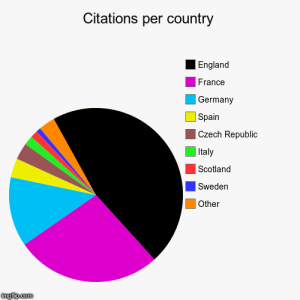https://dmnes.wordpress.com/2015/02/01/taking-stock-february-edition/
I was going to stop doing these monthly recaps with January, because after that you could see first hand what was new and improved. Alas, we haven’t quite made the Jan. 31 goal, so you get one more month’s worth of stats and graphs. We’re up to 16030 individual citations (up from 10288, an increase of nearly 56%!) distributed over 764 entries (up from 639 last month, a 19.5% increase), resulting in an average of 21 citations per name (up from 16 last month, no doubt due to the completion of the extremely popular names John and Joan, both of which have hundreds of citations.)
There are 463 men’s names and 278 women’s, and, excitingly, for the first time in months, our ‘earliest/latest in the alphabet’ names have changed! The alphabetically foremost masculine name is now Achard, of Germanic origin and with French citations, and the alphabetically hindmost name is now Zwentibold, of Slavic origin but influence, in its Latin form, by Germanic elements.
7174 of the citations are from Latin records, that is, around 44.7%, a significant decrease from last month, due no doubt to the large number of 16th C English parish registers that we’ve been working through. Here’s the breakdown for all the languages:

When it comes to citations per country, we’ve now reached the point where we’re constrained by the number of slices we can put into our pie chart (on the free online automatic pie-chart generator we’re using), which means neither Brabant nor Malta show up on the below, despite now having sizeable showings:


When it comes to citations per country, we’ve now reached the point where we’re constrained by the number of slices we can put into our pie chart (on the free online automatic pie-chart generator we’re using), which means neither Brabant nor Malta show up on the below, despite now having sizeable showings:

Lastly, this month the Dictionary welcomed a new assistant to the editorial team:Dr. Mariann Slíz is a member of the Institute of Hungarian Linguistics and Finno-Ugric Studies at Eötvös Loránd University, specializing in Onomastics, Cultural History, Historical Linguistics, Medieval History, Literature, Magical Realism, History of Hungary, Medieval Hungary, Hungarian linguistics, and Anthropology of Personal Names. We are very grateful to have an expert on Hungarian names joining us, in part because it means we can move Hungarian from the second phase to the first phase! So keep a look out for Hungarian citations and citations from Hungary in upcoming editions of the Dictionary.
No comments:
Post a Comment